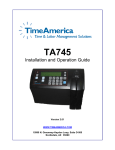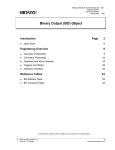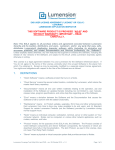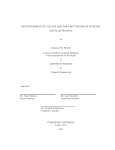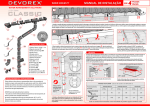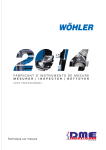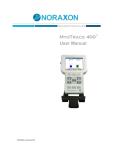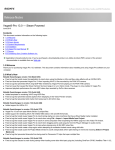Download TA715 Terminal
Transcript
TA715 Installation and Operation Guide Version 2.01 WWW.TIMEAMERICA.COM 15990 N. Greenway-Hayden Loop, Suite D-500 Scottsdale, AZ 85260 iii Table of Contents 1.0 Technical Specifications ........................................................................................................ - 1 - 1.1 Specifications .................................................................................................................... - 1 - 1.2 Available Options ............................................................................................................. - 1 - 1.3 Features ............................................................................................................................. - 2 - 1.3.1 Front Panel ................................................................................................................. - 2 - 1.4 Bottom Connector Panel ................................................................................................... - 2 - 1.5 Internal Components ......................................................................................................... - 2 - 1.5.1 Battery back-up module ............................................................................................. - 2 - 1.5.2 Memory...................................................................................................................... - 3 - 2.0 Unpacking and Inspection ..................................................................................................... - 5 - 2.1 Location/Site Requirements .............................................................................................. - 5 - 2.1.1 Selecting a Location .................................................................................................. - 6 - 2.2 Mounting the Terminal ..................................................................................................... - 6 - 2.2.1 Mounting Procedure .................................................................................................. - 6 - 2.2.3 Communication Connections ..................................................................................... - 6 - 3.0 Terminal Configuration ......................................................................................................... - 7 - 3.1 Entering into Technician Mode ......................................................................................... - 7 - 3.2 Terminal Setup .................................................................................................................. - 8 - 3.2.1 Ethernet ...................................................................................................................... - 8 - 3.2.1.1 Ethernet Connections .............................................................................................. - 8 - 3.2.2 Direct / Serial (RS232) or LAN (RS485) .................................................................. - 9 - 3.2.2.1 RS-232 Cable Connections ..................................................................................... - 9 - 3.2.2.2 RS-485 Cable Connections ................................................................................... - 10 - 3.2.3 Modem ..................................................................................................................... - 11 - 3.2.1.1 Modem Connections ............................................................................................. - 11 - 4.0 Maintenance ........................................................................................................................ - 13 - 4.1 Recovery from Memory Error ........................................................................................ - 13 - 4.2 How to Reset the Memory / Clear the Clock .................................................................. - 13 - 4.2.1 Location of Jumpers ................................................................................................ - 13 - 4.3 Battery Back-Up Modules............................................................................................... - 14 - 5.0 Field Upgrades and Servicing ............................................................................................. - 15 - 5.1 Procedure – Internal Ethernet Card Installation .............................................................. - 15 - 5.2 Procedure – Internal Modem Card Installation ............................................................... - 16 - 5.3 Procedure – Internal Relay Card Installation .................................................................. - 17 - Appendix – A ............................................................................................................................ - 19 - External Wiring Diagrams ......................................................................................................... - 19 - A.1 Bells ............................................................................................................................... - 19 - A.2 RS-232............................................................................................................................ - 19 - A.3 RS-485............................................................................................................................ - 20 - Appendix – B............................................................................................................................. - 21 - Supervisor Mode ....................................................................................................................... - 21 - B.1 Adding Transactions....................................................................................................... - 21 - B.2 Diagnostics Mode ........................................................................................................... - 21 - Appendix – C............................................................................................................................. - 22 - External Connectors .................................................................................................................. - 22 - Appendix – D ............................................................................................................................ - 23 - Jumpers...................................................................................................................................... - 23 - v 1.0 Technical Specifications 1.1 Specifications Dimensions 4.4” x 6.7” x 2.5” Weight 1.69 lbs. Memory 128K RAM, Battery backed. Reader Magnetic Stripe (track 1, 2, or 3) Bar Code (3-of-9, 2-of-5, 128) Display 2x16 LCD backlit Alphanumeric Programming ASCII-based, Over Communication Port Communications Standard: RS-232 Port - Bi-directional Local Communications Standard: RS-485 Port Optional: 14.4 Baud Modem Optional: 10/100 Ethernet Power Voltage: 230 / 115 Vac +10%, 50/60 Hz Consumption: less than 5 watts Environment Operating Temperature -20o -60o C Humidity: up to 95% RH 1.2 Available Options Ethernet Communications: With the optional internal Ethernet card, the terminal can be connected to any 10/100 Ethernet network. Modem Communications: With the optional internal Modem card, the terminal can be located remote to the host location and dialed up using standard analog telephone lines at a speed of 14.4 baud. Signal Control: With the optional internal Relay card, the terminal can control a 12 VDC, 1 Amp dry contact circuit. The signal control relay can be turned on by both a specific employee badge for access control, or by time of day for bell ringing. The duration time is also programmable. -1- 1.3 Features The TA-715 is constructed of injection molded plastic, which, pound for pound is stronger than steel, yet lightweight and attractive. The terminals have a domed membrane keypad, which creates a watertight seal against external elements. 1.3.1 Front Panel The TA-715 Terminal has the following front panel features: 1. 2x16 Character LCD backlit display a. The terminal comes with a highly advanced filtered LCD display. This means that under almost any lighting condition, the terminal will give you a clear picture to read the screen. 2. 10 alpha-numeric keys, 6 programmable function keys, and 6 special keys (IN, OUT, ENTER, BACK SPACE and ON). 3. The Alarm light “!”, is located to the left of the display. a. The alarm light is an LED that lights when at least half of the memory is used; its blinks when the memory is almost full. 1.4 Bottom Connector Panel The connector panel is located at the bottom of the casing. Warning: The “HOST”, “Relay”, “Sensor”, “NET”, and “Reader” connections are for indoor use only and not intended for connection to exposed outdoor lines. TA-715 Host: Serial RS232/485 HOST Optional Optional: Ethernet / Modem / Relay 1.5 Internal Components 1.5.1 Battery back-up module The terminal has two back-up battery modules, one for the real time clock memory and the other for operation during a power failure. The standard memory back-up module is a 1 year span lithium battery, keeping the internal clock running and the memory intact. -2- The battery (in addition to the standard memory back-up) is self-contained. This allows operation of the terminal during a power failure as follows: • TA-715 – In standard configuration (not including an option-card) for 40 minutes. A shut down timeout feature enables longer operation time. During a power failure, the user presses the [ON] key to activate the terminal. Data can then be entered and stored in the terminals memory. Timeout will cause the terminal to shutdown automatically after the last use of the terminal, until the [ON] key is pressed again. Note: Plug the terminal into a main power source, for at least 18 hours continuously before relying on the battery backup. 1.5.2 Memory The TA-715 has 128 Kbyte of user memory, providing storage for data from more than 10,000 simple operations depending on programming table’s length, and the complexity of collected data. -3- Notes: ________________________________________________ ________________________________________________ ________________________________________________ ________________________________________________ ________________________________________________ ________________________________________________ ________________________________________________ ________________________________________________ ________________________________________________ ________________________________________________ ________________________________________________ ________________________________________________ ________________________________________________ ________________________________________________ ________________________________________________ ________________________________________________ ________________________________________________ ________________________________________________ ________________________________________________ ________________________________________________ ________________________________________________ ________________________________________________ ________________________________________________ ________________________________________________ ________________________________________________ ________________________________________________ ________________________________________________ ________________________________________________ ________________________________________________ ________________________________________________ ________________________________________________ ________________________________________________ ________________________________________________ -4- 2.0 Unpacking and Inspection Note: Do not throw away the box or packing materials. Check the box and the contents for any signs of damage that may have happened during shipment. Carefully unpack and check the contents. The following items should be present: 1 TA-715 Terminal 1 Mounting Panel Connecting/Splitter Box with cable (if ordered as serial clock) 10 Meter Serial Communication cable Four Phillips flat head 3.5x30mm anchors, for terminal mounting Connector Cover Template for mounting the terminal 2.1 Location/Site Requirements The terminal can be installed in any normal office or factory environment. Controlled environments are not required for proper operation of the terminal. However, installing and operating the terminal under adverse conditions may affect the functionality of the unit. Warning: The “HOST”, “Relay”, “Sensor”, “NET”, and “Reader” connections are for indoor use only and not intended for connection to exposed outdoor lines. -5- 2.1.1 Selecting a Location Consider the following environmental factors that may affect the operation of the terminal, when considering a location: • • • The cable should not be installed near EMI (Electromagnetic Interference) sources o Motors, generators, alternators and transformers. o Air conditioners, elevators, etc. o Radio/Television transmitters, signal generators and internal communication networks. Cables should not be within: o 30 cm. (1 ft.) range from 5 KVA power lines or less. o 60 cm. (2 ft.) range from 5-10 KVA power lines. o 1.5 meters (5 ft.) range of power lines exceeding 10 KVA. Cables should not run parallel to power lines for more then 15 m. (49 ft.) 2.2 Mounting the Terminal Make sure the unit is unplugged, and that it is not connected to the network/PC. Caution: The terminal should not be mounted where it will be exposed to extreme heat or cold, water, steam, violent vibrations, high electromagnetic radiation including high voltage power lines and electrical equipment. Place the terminal near an easily accessible power source. Select an appropriate location for the terminal the recommended height from the floor is 120 cm. (3’ 11”). 2.2.1 Mounting Procedure The following procedure explains how to mount the terminal to the wall. 1. Remove the back panel by lightly pushing outward on the tab and pulling down on the panel. Also remove the connector cover from the bottom of the terminal. 2. Using the Mounting Template that came inside the box, place the template onto the wall at the correct height, making sure that the template is level. 3. Drill holes using a 6 mm. (1/4”) drill bit. If the communication cable is to be wired through the wall, wire one end. Warning: Live wires in the vicinity may contain 115v or 230v. Make sure not to drill into any electric wires. Failure to heed this warning may result in serious injury or death. 4. 5. 6. 7. 8. Using the 4 screws that came with the terminal, screw the panel to the wall. Slide the terminal over the panel hinges. Connect the communication cable. Plug the terminal into the power socket. Re-Place the connector cover at the bottom. 2.2.3 Communication Connections 1. Select a location for the connection box. a. The box must be positioned where both the communication line and the terminal can be connected to it. 2. Plug the terminal communication cable into the connection box. 3. Wire an additional connection for Ethernet. 4. If an internal modem has been added and the modem is used, plug the phone line into the modem connection. Do not use the terminal communication cable. -6- 3.0 Terminal Configuration The TA-715 Terminals can be connected to the host computer using either RS-232(Direct), RS485(LAN), Ethernet or Modem communications. 3.1 Entering into Technician Mode The TA-715/ Terminals contain a built in configuration program called “Technician Mode”. Technician mode enables the setting up of the following options: Real Time Clock (RTC) Calibration Baud Rate Station ID settings Modem Rings Network Connection Settings To enter technician mode: • For TA-715 o If the Terminal is displaying the date and time. Press [F1] and [F2] keys simultaneously 6 times to enter into Technician mode. o If the Terminal is displaying “No Prog”, press the [0] key 6 times, then press the [ENTER] key to get into Technician mode.. If the clock has a Barcode reader or a Magnetic reader, using a badge with six zeros (000000) will work as well. o Use the [ENTER] key to move from one screen to the next. To return to the previous screen, use the [Back Space] key. Note: some menus once you are past them, you do not have the ability to back-up. -7- 3.2 Terminal Setup 3.2.1 Ethernet The following describes the different selections within Technician mode for setting up the TA-715 terminal for use with Ethernet communications. On the left is the setting as it is displayed on the clock screen, on the right in bold is the default setting. 1. ADJUST RTC (N/Y): o Option is for internal clock calibration purposes. 2. SERIAL PORT 0 FOR BAUDRATE: 3. STATION ID: a. For Ethernet communications, leave this setting at its default of zero. Note: This number must match the ID in the software. 4. MODEM RINGS(0): 5. NETWORK (N/A/B): NO/A-CARD/B-CARD a. Use the [F2] key to select option B. 6. POLLING SEC.: N 19200 0 N B 0 PLEASE, WAIT… PRESS [ENTER] KEY 7. MY IP ADDRESS: 8. GATEWAY ADDRESS: 9. REMOTE ADDRESS: a. This option will always be all zeros. 10. SUBNET MASK: 11. MY PORT: 12. HOST PORT: a. Must match My Port from option 12. 13. DISCONCT SEC: XXX.XXX.XXX.XXX XXX.XXX.XXX.XXX 000.000.000.000 XXX.XXX.XXX.XXX 03734 03734 30 PLEASE, WAIT… PRESS [ENTER] KEY 3.2.1.1 Ethernet Connections For the TA-715 terminals, you plug the Ethernet cable into the optional port. Use the following images as a guideline for determining the locations of the proper port. Optional Port -8- 3.2.2 Direct / Serial (RS232) or LAN (RS485) The following describes the different selections within Technician mode in the for RS-232 and RS-485 communications. On the left is the setting on the clock screen, and in bold on the right is the default setting. Unless otherwise specified, the settings should always be left at the default values. 1. ADJUST RTC (N/Y): 2. SERIAL PORT0 FOR BAUDRATE: a. Note: If using XactTime, the baud rate must be set to 9600. 3. STATION ID: a. The Station ID is a unique identifier for multi-terminal communication. The range is from 0 to 31, and must match the setting in the software. Default is 0. Each terminal in the series must have a unique number. 4. MODEM RINGS(0): 5. NETWORK (N/A/B): NO/A-CARD/B-CARD N 19200 0 N N 3.2.2.1 RS-232 Cable Connections RS-232 uses the DB9 Serial Adapter (Part: CBL-1195) and a serial cable (Part: 620046). The DB9 Serial Adapter plugs into the back of the Host PC using an available serial port, and the cable plugs into the Serial Adapter and the HOST port on the bottom of the clock. Note: Supported distances for cabling is currently 50 feet. HOST Port -9- 3.2.2.2 RS-485 Cable Connections RS-485 uses an External converter (Part: ACC-2050) and a standard 4 wire phone style cable. Using this method, you can connect multiple clocks thru a single serial connection on the Host PC. You can connect multiple versions of the TA7xx series terminals in series this way. HOST Port - 10 - 3.2.3 Modem The following describes the different selections within Technician mode in the TA-715 for modem communications. On the left is the setting on the clock screen, and in bold on the right is the default setting. Unless otherwise specified, the settings should always be left at the default values. 1. ADJUST RTC (N/Y): 2. SERIAL PORT0 FOR BAUDRATE: 3. STATION ID: a. The Station ID is a unique identifier for multi-terminal communication. The range is from 0 to 31, and must match the setting in the software. Default is 0. 4. MODEM RINGS(0): a. This can be any number between 1 and 9, and is the setting on how many rings before the clock will answer. 5. NETWORK (N/A/B): NO/A-CARD/B-CARD N 19200 0 2 N 3.2.1.1 Modem Connections For the TA-715 terminals, you plug the Phone cable into the optional port. Use the following images as a guideline for determining the locations of the proper port. Optional Port - 11 - Notes: ________________________________________________ ________________________________________________ ________________________________________________ ________________________________________________ ________________________________________________ ________________________________________________ ________________________________________________ ________________________________________________ ________________________________________________ ________________________________________________ ________________________________________________ ________________________________________________ ________________________________________________ ________________________________________________ ________________________________________________ ________________________________________________ ________________________________________________ ________________________________________________ ________________________________________________ ________________________________________________ ________________________________________________ ________________________________________________ ________________________________________________ ________________________________________________ ________________________________________________ ________________________________________________ ________________________________________________ ________________________________________________ ________________________________________________ ________________________________________________ ________________________________________________ ________________________________________________ ________________________________________________ - 12 - 4.0 Maintenance 4.1 Recovery from Memory Error If the terminal gives a memory error, a message “MEM CRASH” will appear on the screen. To recover from this memory crash, follow the steps below. • For TA-715 1. Press the [0] key 6 times. 2. Press the [Enter] key once. 3. Press the [F2] key 3 times. 4. Press the [F5] key twice. 5. Press the [F2] key 3 times. o The message “CLEAR MEMORY?” will appear on the display. 6. Press the [F5] key once. o The message “MEMORY CLEARED” will appear on the display. 7. The message “NO PROG” will now be on the display. 8. Program the clock from within the software. o Note – From TA-100Pro or GenPro/SQL on the polling screen when the clock is selected to the right, press CTRL+ALT+A. It will ask you to send the application to the clock, select Yes; then click the poll button. 4.2 How to Reset the Memory / Clear the Clock Warning: This function should be performed by qualified personnel only. It requires working with an open unit. Make sure to unplug the unit wherever the instructions call for it. Take extreme care during the stages where the terminal is plugged into a power source. 4.2.1 Location of Jumpers Use the following steps reset the memory, causing a Memory Crash. 1. Unplug the terminal and make sure that it is powered off. a. The terminal will shut down after 15 seconds of being unplugged from the power. 2. Unscrew and remove the front panel. 3. Remove the J3 jumper from the 1-2 position and place it in the 2-3 position, use the following image as a guide for the location of the jumper. 4. Remove the J3 jumper from position 2-3 and put back into the 1-2 position. 5. Replace the front panel, and insert the screws. 6. Plug the Terminal back into a power source and make sure that “MEM CRASH” appears in the terminal display. 7. Follow the steps from section 5.1 on recovering from the “MEM CRASH” state. - 13 - 4.3 Battery Back-Up Modules The TA-715 terminal has two back-up battery modules, one for the real time clock memory and the other for operation during a power failure. The standard memory back-up module is a lithium battery, which will keep the internal clock running and the memory intact, for up to 30 days during a power failure. The back-up battery provided (in addition to the standard memory back-up) is a self-recharging system which allows the terminal to be operated during a power failure. The battery provides power for 1-1/2 net hours of use. A shut down time-out feature enables the terminal to operate for more extended periods of time. During a power failure, the user presses the [ON] key to activate the terminal. Data can then be entered and stored in the terminal’s memory. The time-out will cause the terminal to shut down automatically after the last use of the terminal, until the [ON] key is pressed again. Warning: Risk of explosion may occur if the lithium battery is replaced by an incompatible battery. You must dispose of used batteries as per the manufacturer’s instructions. - 14 - 5.0 Field Upgrades and Servicing One of the features of the TA-715 terminal is the ability to do field upgrades and servicing. This section provides an explanation on how to perform the following upgrades: • • • Internal Ethernet Card Installation Internal Modem Card Installation Internal Relay Card Installation Warning: These functions should only be performed by qualified personnel only. It requires working with an open unit. Make sure to unplug the unit wherever the instructions call for it. Take extreme care during the stages where the terminal is plugged into a power source. 5.1 Procedure – Internal Ethernet Card Installation NOTE: Refer to the section 3.2.1 for additional information of the configuration setting for this option. 1. Unplug the Terminal and make sure that it is powered off. a. The terminal will shut down after 15 seconds. 2. Unscrew and remove the front panel. 3. You may need to punch out the opening for the accessory connection, and cut away 1/16” on top and 1/16” to the left or the opening to make room for the RJ-45 connector. 4. Install the Ethernet card into the TA-715 terminal using the below image as a reference. - 15 - 5. Once the card is installed properly, it should look like the image below. 6. Replace the front panel, insert the screws. 7. Plug the terminal back into a power source and make sure that the date/time appears in the terminal display. 8. Plug the Ethernet cable into newly installed Ethernet card. 5.2 Procedure – Internal Modem Card Installation This section explains how to install the internal Modem card option. NOTE: Refer to the section 3.2.3 for additional information of the configuration setting for this option. 1. Unplug the Terminal and make sure that it is powered off. a. The terminal will shut down after 15 seconds. 2. Unscrew and remove the front panel. 3. Install the Modem card into the TA-715 terminal using the below image as a reference. - 16 - 4. Once the card is installed properly, it should look like the image below. 5. Replace the front panel, replacing the screws. 6. Plug the Terminal back into a power source and make sure that the date/time appears in the terminal display. 7. Plug the phone cable into newly installed modem card. 5.3 Procedure – Internal Relay Card Installation This section explains how to install the internal Modem card option. 1. Unplug the terminal and make sure that it is powered off. a. The terminal will shut down after 15 seconds. 2. Unscrew and remove the front panel. 3. Install the relay card into the TA-715 terminal. 4. Once the card is installed properly, it should look like the image below. 5. Replace the front panel, replacing the screws. 6. Plug the Terminal back into a power source and make sure that the date/time appears in the terminal display. - 17 - Notes: ________________________________________________ ________________________________________________ ________________________________________________ ________________________________________________ ________________________________________________ ________________________________________________ ________________________________________________ ________________________________________________ ________________________________________________ ________________________________________________ ________________________________________________ ________________________________________________ ________________________________________________ ________________________________________________ ________________________________________________ ________________________________________________ ________________________________________________ ________________________________________________ ________________________________________________ ________________________________________________ ________________________________________________ ________________________________________________ ________________________________________________ ________________________________________________ ________________________________________________ ________________________________________________ ________________________________________________ ________________________________________________ ________________________________________________ ________________________________________________ ________________________________________________ ________________________________________________ ________________________________________________ - 18 - Appendix – A External Wiring Diagrams A.1 Bells To connect a bell system to the clock use the cable and connection box that came with the clock and wire it according to the following diagram: TA-715 – Cable 620047 Signal Control: With the optional internal relay card, the terminal can control a 12 VDC, 1 Amp dry-contact circuit. The signal relay can turned on by time of day for bell ringing. The duration time is also programmable. A.2 RS-232 RS-232 uses the DB9 Serial Adapter (Part: CBL-1195) and a serial cable (Part: 620046). Note: Supported distances for cabling is currently 50 feet. - 19 - A.3 RS-485 RS-485 uses the External converter (Part: ACC-2050) and a standard 4 wire phone style cable. Using this method, you can connect multiple clocks thru a single serial connection on the Host PC. - 20 - Appendix – B Supervisor Mode You can assign multiple badge numbers to enter into Supervisor mode, but you cannot use those numbers to clock in with. B.1 Adding Transactions Use the following steps to add transactions into the terminal: NOTE: The clock is programmed initially with a supervisor badge of 11111. This badge number will normally be cleared the first time you program the clock if you use different badge numbers or badge lengths for supervisors. Step 1. Step 2. Step 3. Step 4. Step 5. Step 6. Step 7. Enter the supervisor badge number and press [ENTER]. From the menu select (1) – Add. Enter the date of the transaction in MM/DD/YY format, then press [ENTER]. Enter the time of the transaction in military time, then press [ENTER]. Enter the badge number of the employee, then press [ENTER]. Enter the function for the transaction. Press [BACK SPACE], to get back to the previous menu. B.2 Diagnostics Mode Use the following step to go through the options within the Diagnostics Mode of the terminal: Step 1. Enter the supervisor badge number and press [ENTER]. Step 2. From the menu that appears select (2) Diag (or Diagnostics if no finger reader is installed). Step 3. Complete the testing for each group you want to diagnose, pressing the [ENTER] key to go onto the next test item or using the [BACKSPACE] key to the previous test item: a. b. c. d. e. f. Mag or Prox – stands for Magnetic or Proximity Reader • For Terminals that are equipped with a Magnetic or Proximity reader, if you swipe the badge or bring the badge to the terminal it will display the number of the badge on the screen. BC – stand for Bar Code Reader • For Terminals that are equipped with a Bar Code reader. The Screen displays 4 options for the type of badge you are using, select the badge type by pressing it’s corresponding number associated with your badge type. • If you swipe the badge it will display the number of the badge on the screen. Select Relay 1-2 – for testing of the terminals two relay ports. • For testing equipment connected to the terminals relays. • Press the corresponding number associated with the relay you have connected to the terminal and it will cause that relay to engage. Select Led#: 1-6 – this feature is not used • This feature is not used, you can press the [ENTER] key to bypass the option. Select Sensor 1-4 – this feature is not used. • This feature is not used, you can press the [ENTER] key to bypass this option. Keypad – used for testing the keys on the keypad • Press keys on the keypad and they will display to the screen. Step 4. Press [ENTER] to exit out from the last Diagnostics menu selection. - 21 - Appendix – C External Connectors HOST RJ-45 (8 pin) – P4 Communication with Host computer Pin Signal 1 2 3 4 5 6 7 8 NC RS-485 (-TRX) RS-485 (+TRX) GND RS-232 (TXD) RS-232 (RXD) NC NC Value 0 – 5 Volt 0 – 5 Volt -12: +12Vdc -12: +12Vdc RJ-45 (Ethernet – P1 Optional net card A. For Ethernet: (Set J15, J16 and J17) Pin Signal Value 1 2 3 4 5 6 7 8 Transmit data Transmit data Receive data NC/Vin/Shield NC/Vin/Shield Receive data NC/GND/Shield NC/GND/Shield TX+ TXRX+ Remarks 10Base-T/Power over LAN/100Base-T 10Base-T/Power over LAN/100Base-T 10Base-T/Power over LAN/100Base-T B. For 14,400 Modem: (Set J15, J16 and J17) Pin Signal 1 2 3 4 5,6 NC NC Ring TIP NC Value OPOP+ C. For 2,400 Modem +I/O Pin Signal Function 1 2 3 4 5 6 Relay 1 Sensor 1 Ring TIP Sensor 2 Relay 2 Output Input Modem Modem Input Output D. For 14,400 Modem: (Set J15, J16 and J17) Pin Signal 2 4 7 VCC DATA GND - 22 - Appendix – D Jumpers Printed side (PCB No. 310-C112-05-C) - 23 - Display Card – TA715 - 24 - Miscellaneous * - TA-715 Terminals ** - TA-777 Terminals - 25 -































